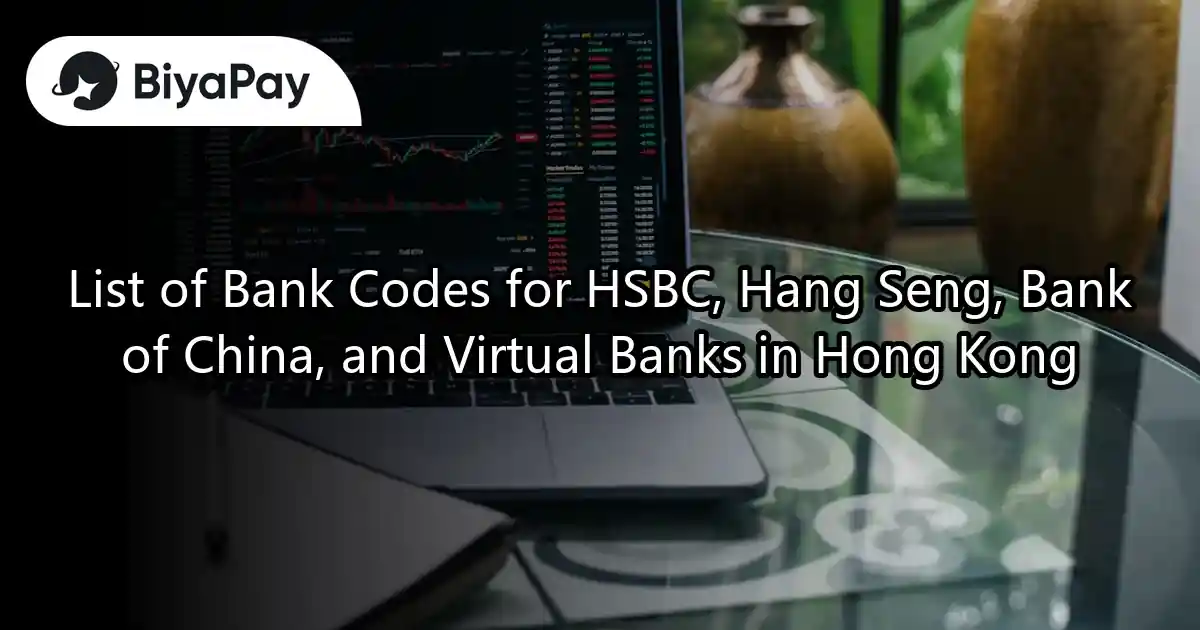- EasyCard
- Trade
- Help
- Announcement
- Academy
- SWIFT Code
- Iban Number
- Referral
- Customer Service
- Blog
- Creator
List of Bank Codes for HSBC, Hang Seng, Bank of China, and Virtual Banks in Hong Kong

Image Source: unsplash
In Hong Kong, bank codes are crucial for daily transactions. They help you quickly identify banks and branches, ensuring transactions are completed accurately. For example, HSBC’s bank code is 004, while Hang Seng Bank’s is 024. When you are familiar with these codes, daily transfers or automatic payments become more efficient, reducing the chance of errors.
HSBC Bank Codes
Head Office and Major Branch Bank Codes
HSBC’s head office in Hong Kong has a bank code of 004, which is one of the most commonly used codes in banking transactions. In addition to the head office, HSBC has multiple major branches, each with its own unique bank code. For example, the Central branch may have a different code from branches in Kowloon or the New Territories. These codes help you accurately select the target branch when processing transfers or payments.
Tip: When making interbank transfers or setting up automatic payments, confirming the correct bank code is crucial. This can prevent transaction failures or delays.
Below is a simple table listing the bank codes for HSBC’s head office and some major branches:
| Branch Name | Bank Code |
|---|---|
| Head Office | 004 |
| Central Branch | 012 |
| Kowloon Branch | 015 |
| New Territories Branch | 018 |
How to Find HSBC Bank Codes
Finding HSBC bank codes is very straightforward. You can quickly obtain the necessary information through the following methods:
- HSBC Official Website: Visit HSBC’s official website and use the branch locator tool to find the corresponding bank code by entering the region name.
- Mobile App: Download the HSBC mobile app, log in, and view your branch information and related codes.
- Customer Service Hotline: Call HSBC’s customer service hotline to inquire about the bank code for a specific branch.
- Bank Statement: Check your bank statement, which typically lists your branch name and bank code.
Suggestion: If you frequently handle banking transactions, noting down the bank codes of commonly used branches will make your operations more efficient.
Hang Seng Bank Codes
Head Office and Major Branch Bank Codes
Hang Seng Bank’s head office code is 024, one of the most commonly used codes for banking transactions. Besides the head office, Hang Seng Bank has multiple branches across Hong Kong, each with its own unique bank code. These codes help you accurately identify the transaction recipient, especially during interbank transfers or when setting up automatic payments.
Below is a simple table listing the bank codes for Hang Seng Bank’s head office and some major branches:
| Branch Name | Bank Code |
|---|---|
| Head Office | 024 |
| Mong Kok Branch | 128 |
| Sha Tin Branch | 223 |
| Tsuen Wan Branch | 305 |
Tip: When filling out banking details, ensure the branch name matches the bank code to avoid transaction failures due to input errors.
How to Find Hang Seng Bank Codes
You can quickly find Hang Seng Bank’s bank codes through the following methods:
- Hang Seng Bank Official Website: Visit Hang Seng Bank’s official website and use the branch locator function to obtain the relevant code by entering the region name.
- Mobile App: Download the Hang Seng Bank mobile app, log in, and view your branch information and bank codes.
- Customer Service Hotline: Call Hang Seng Bank’s customer service hotline to inquire about the bank code for a specific branch.
- Bank Statement: Check your bank statement, which typically lists your branch name and related code.
Suggestion: If you frequently handle banking transactions, noting down the bank codes of commonly used branches will make your operations more efficient.
Bank of China (Hong Kong) Bank Codes
Multiple Bank Codes for Bank of China (Hong Kong)
Bank of China (Hong Kong) has multiple bank codes used to identify different branches and services. The head office bank code is 012, one of the most commonly used codes. In addition, Bank of China (Hong Kong) has other codes, such as 014 and 019, representing different branches or specific services. These codes ensure you can accurately select the target branch during transactions, avoiding errors.
Below is a simple table listing the bank codes for some major branches of Bank of China (Hong Kong):
| Branch Name | Bank Code |
|---|---|
| Head Office | 012 |
| Wan Chai Branch | 014 |
| Tsim Sha Tsui Branch | 019 |
| Yuen Long Branch | 021 |
Tip: When filling out banking details, ensure the branch name matches the bank code. This ensures transactions are completed smoothly.
How to Quickly Find Bank of China (Hong Kong) Codes
Finding Bank of China (Hong Kong) bank codes is not difficult. You can use the following methods to quickly obtain the necessary information:
- Bank of China (Hong Kong) Official Website: Visit the official website of Bank of China (Hong Kong) and use the branch locator tool to find the corresponding bank code by entering the region name.
- Mobile App: Download the Bank of China (Hong Kong) mobile app, log in, and view your branch information and related codes.
- Customer Service Hotline: Call the Bank of China (Hong Kong) customer service hotline to inquire about the bank code for a specific branch.
- Bank Statement: Check your bank statement, which typically lists your branch name and bank code.
Suggestion: If you frequently conduct banking transactions, noting down the bank codes of commonly used branches will make your operations more efficient.
Virtual Bank Codes

Image Source: pexels
Characteristics of Virtual Bank Codes
Virtual bank codes have unique characteristics. These codes are typically assigned by the Hong Kong Monetary Authority to identify virtual bank transactions. Since virtual banks have no physical branches, their codes are not divided by region like traditional banks. You only need to remember one code to complete all transactions. This simplified coding system makes virtual bank operations more convenient, especially for users who frequently use online banking services.
Tip: Virtual bank codes are usually provided during account opening. Saving this information can avoid future lookup hassles.
Common Virtual Banks and Their Codes
The number of virtual banks in Hong Kong is gradually increasing. Below are some common virtual banks and their bank codes:
| Virtual Bank Name | Bank Code |
|---|---|
| WeLab Bank | 170 |
| ZA Bank | 169 |
| Mox Bank | 175 |
| Livi Bank | 176 |
These virtual banks offer a variety of financial services, including deposits, loans, and payment functions. You can choose a virtual bank that suits your needs.
Suggestion: When selecting a virtual bank, understanding its bank code and service scope can help you better manage your finances.
Differences Between Virtual Bank Codes and Traditional Bank Codes
Virtual bank codes differ significantly from traditional bank codes. Traditional bank codes are typically divided by branch, with each branch having a unique code. In contrast, virtual banks, lacking physical branches, use a single code to represent the entire bank. This design simplifies the transaction process and reduces issues caused by selecting the wrong branch.
Virtual bank codes are also easier to remember. You don’t need to memorize multiple branch codes as with traditional banks. This is a significant advantage for users who frequently conduct online transactions.
Note: Although virtual bank codes are simple, you still need to ensure they are entered correctly to avoid transaction failures.
Uses of Bank Codes

Image Source: pexels
Role of Bank Codes in Transfers
Bank codes play a critical role in transfers. When making interbank transfers, the bank code helps the system accurately identify the recipient bank and branch. This ensures funds are correctly delivered to the designated account. For example, when transferring from HSBC to Hang Seng Bank, entering the correct bank code (e.g., 024 for Hang Seng Bank) is essential. If the code is incorrect, the funds may fail to transfer or even be returned.
In online banking or mobile apps, the bank code is typically entered along with the account number. You only need to verify the code’s accuracy to complete the transaction. This design simplifies the process and reduces the likelihood of errors.
Tip: When filling out bank codes, double-check the information. If unsure of the code, use the bank’s official website or customer service for verification.
Application of Bank Codes in Automatic Payments
Automatic payments are a common financial service in daily life, such as paying utility bills or credit card statements. Bank codes are crucial when setting up automatic payments. They help the system identify the payment bank and branch, ensuring monthly deductions are made on time.
When setting up automatic payments, the system will require you to provide the bank code and account number. For example, if you use Bank of China (Hong Kong) services, entering the correct bank code (e.g., 012) ensures smooth payments. This prevents delays or penalties due to code errors.
Suggestion: Before setting up automatic payments, verify the bank code. Save the relevant information for easy reference later.
How to Avoid Transaction Failures Due to Bank Code Errors
Bank code errors can lead to transaction failures, potentially affecting your financial plans. Below are several ways to avoid errors:
- Use Official Resources: Check the bank’s official website or mobile app for the latest bank code information.
- Verify Information: When filling out bank codes, carefully confirm that the branch name and code match.
- Save Records: Keep a record of commonly used branch codes in your phone or notebook for easy access.
- Contact Customer Service: If in doubt, call the bank’s customer service hotline to confirm the code with a professional.
Note: Avoid using unofficial sources for code information, as this may lead to errors. Choosing reliable verification methods ensures transaction safety.
Bank codes are indispensable tools in daily transactions. They can enhance the efficiency of data sharing and ensure transactions are completed accurately. It is recommended to use the following methods to quickly find codes:
- Browse the bank’s official website.
- Contact customer service.
Being familiar with the codes of commonly used banks allows you to handle transfers and payments more efficiently, saving time.
FAQ
How can I confirm if a bank code is correct?
You can check the code using the bank’s official website or mobile app. Reviewing your bank statement or contacting customer service can also help confirm the correct code.
Tip: Avoid using unofficial sources for code information to ensure transaction safety.
Do virtual bank codes need regular updates?
Virtual bank codes typically do not change. You only need to save the code provided during account opening for long-term use.
Note: If the bank undergoes significant updates, the official website will notify users.
Do bank codes affect cross-border transactions?
Bank codes are primarily used for local transactions. Cross-border transactions typically require SWIFT codes or IBAN rather than bank codes.
Suggestion: Before conducting cross-border transactions, confirm the required codes or information.
HSBC (004), Hang Seng (024), Bank of China (012), and virtual bank codes streamline local transfers and autopayments, but how can you achieve cost-effective and convenient cross-border transactions? BiyaPay offers a seamless digital financial platform, enabling trading in U.S. and Hong Kong stocks without offshore accounts, simplifying cross-border investments while complementing the efficiency of local bank codes.
Supporting USD, HKD, and 30+ fiat and digital currencies with real-time exchange rate transparency, plus global remittances to 190+ countries with remittance fees as low as 0.5%, it outperforms traditional banking’s costly processes. A 5.48% annualized yield savings product with no lock-in period balances returns and liquidity, ensuring flexible fund management. Sign up for BiyaPay today to combine the efficiency of Hong Kong bank codes with BiyaPay’s global financial tools for fast, cost-effective wealth management!
*This article is provided for general information purposes and does not constitute legal, tax or other professional advice from BiyaPay or its subsidiaries and its affiliates, and it is not intended as a substitute for obtaining advice from a financial advisor or any other professional.
We make no representations, warranties or warranties, express or implied, as to the accuracy, completeness or timeliness of the contents of this publication.




Contact Us
Company and Team
BiyaPay Products
Customer Services
is a broker-dealer registered with the U.S. Securities and Exchange Commission (SEC) (No.: 802-127417), member of the Financial Industry Regulatory Authority (FINRA) (CRD: 325027), member of the Securities Investor Protection Corporation (SIPC), and regulated by FINRA and SEC.
registered with the US Financial Crimes Enforcement Network (FinCEN), as a Money Services Business (MSB), registration number: 31000218637349, and regulated by FinCEN.
registered as Financial Service Provider (FSP number: FSP1007221) in New Zealand, and is a member of the Financial Dispute Resolution Scheme, a New Zealand independent dispute resolution service provider.



















